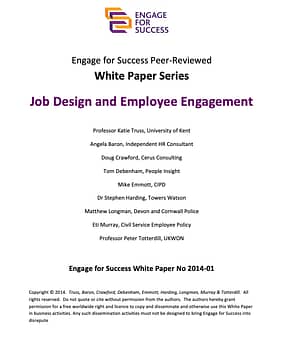Job Design and Engagement
Job design and engagement was the topic of a Thought and Action Group led by Katie Truss, Professor of Management and Director of Knowledge Exchange in the Department of Business and Management at Sussex University
The purpose of the Group was to find out how organisations can address the vital question of how to design engaging jobs, for all kinds of workers. Research suggests that the design of people’s jobs is one of the most significant factors influencing engagement levels. Studies have shown that jobs which offer such experiences as variety, challenge and end-to-end responsibility facilitate high levels of engagement. However, job design seems to have fallen from favour in recent years within the HRM community, and receives less attention than some other, more popular, topics. Many practitioners are not aware of the importance of job design in raising engagement levels, or how to go about designing engaging jobs, but there are also some great examples of best practice that could be more widely disseminated.
Thought piece introducing the White Paper
Job design is the process of putting together a range of tasks, duties and responsibilities to create a composite for individuals to undertake in their work and to regard as their own. It is crucial: not only is it the basis of individual satisfaction and achievement at work, it is necessary to get the job done efficiently, economically, reliably and safely.’ (Torrington et al., 2011: 84)
F.W. Taylor’s ‘Scientific Management’ approach
Ever since jobs have existed, debate has raged about the best way to design them. F.W. Taylor’s ‘Scientific Management’ approach developed during the Industrial Revolution suggested that jobs should be broken down into simple and repetitive tasks in order to maximise productivity. This encouraged employers to create jobs that allowed individual workers very limited scope for innovation, creativity and variety, and inevitably led to boredom and dissatisfaction.
Individual motivational needs should be taken into account
During the mid-20th Century as the Human Relations movement emerged, there was an increased realisation that individual motivational needs should be taken into account in the way work was designed, leading to an emphasis on allowing people scope within their work for social interaction, personal development, and the realisation of their own ambitions (Garg and Rastogi, 2006).
Since then, there has been a growing volume of research exploring how to bring these elements together so that jobs can be designed both to maximise the engagement and satisfaction of individual workers on the one hand, and maximise the productivity and performance of organisations on the other. There is now considerable evidence that individuals’ experience of their day-to-day work directly affects their engagement levels, and also their personal effectiveness (Morgeson et al., 2011; Shantz et al., 2013). Related issues include how jobs are embedded within their broader organisational contexts, how they interrelate with one another, and the design of the wider organisation itself. As well as being important for engagement, job design has been shown to be important for the health of workers as well (Grzywacz and Dooley, 2003).
Job design remains a topic that receives much less attention
However, job design remains a topic that receives much less attention from employers and policymakers as a driver of engagement compared with other aspects of management such as leadership or management style (Truss, 2012). There is a dearth of information available for employers on the key principles of job design and the major factors that need to be taken into consideration when designing engaging jobs. This is a cause for concern, particularly in light of findings such as those from Cerus Consulting who, in a recent survey of their client group, found that 68% said that the single most important factor for high levels of engagement was ‘doing a job that is challenging and varied and which makes a meaningful contribution’.
Evidence demonstrating the impact of job design on engagement
Our White Paper outlines the evidence demonstrating the impact of job design on engagement, and to provide employers with insight into how to design jobs that will maximise levels of engagement.
We draw on research findings and best practice examples in the area of job design and focus on the following areas:
- Does job design matter for engagement?
- The content of jobs – what are the key factors that distinguish engaging jobs?
- Work environment – the setting within which work takes place.
- The role of the manager in creating engaging jobs

